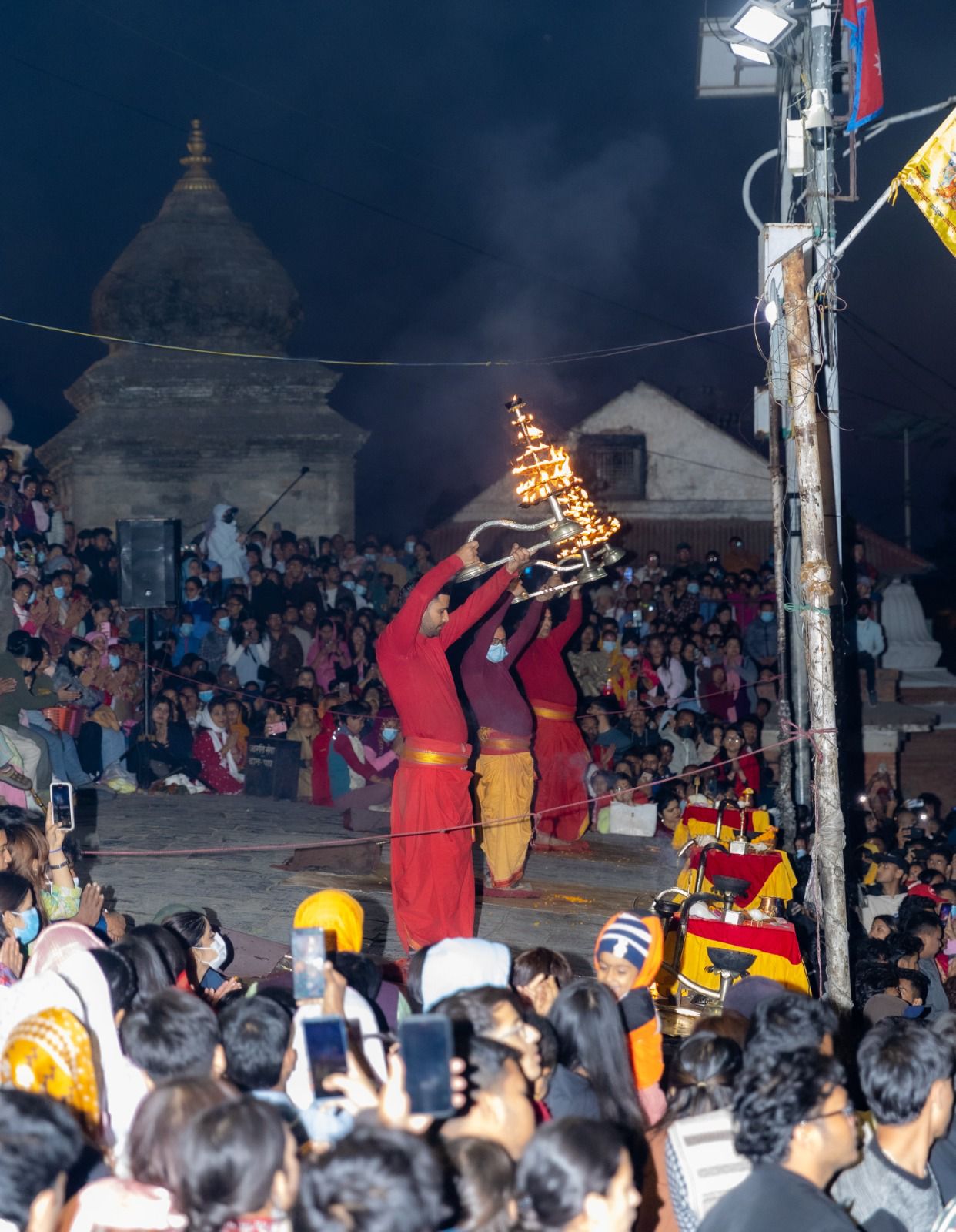Culture & Lifestyle
One chant, many callings: Why people gather for Pashupati’s aarati
Each evening, Kathmandu’s Bagmati banks glow with sankha sounds and gokul dhoop, offering pilgrims, travellers, and seekers a peaceful space for reflection.
Reeva Khanal
If there is one place in Kathmandu that resonates deeply with both pilgrims and travellers, it is the sacred grounds of the Pashupatinath Temple. Recognised as a UNESCO World Heritage Site, its history is believed to date back to around 400 BC, making it one of the oldest and most revered Hindu temples in Nepal. Among its many rituals and traditions, the evening aarati has become a spectacle that visitors from near and far eagerly await.
The experience is far more personal and profound for those who gather along the Bagmati River. Some come out of deep devotion, others seek peace or answers to unspoken questions. A few are drawn simply by the crowd’s energy, or to capture the ritual on camera, while others arrive with quiet intentions known only to themselves.
Bhuwan Chalise, who works as an aarati pujari at the Pashupati temple, reflects on the rich history and enduring significance of the aarati. He shares that the tradition is deeply rooted and began in 2007. The third Monday of Shrawan marks its annual celebration, during which five Brahman priests perform five aaratis as part of the ritual. “The idea of bringing the aarati to Pashupati originated from Banaras,” he explains, “where three devotees, Dharamadas Budhathoki, Ramesh Pokhrel, and Durga Prasad Khatiwada, witnessed the ritual and felt compelled to introduce it in Nepal.”
The ceremony, he notes, brings together a host of key pandits and musicians, including Mukunda Pokhrel, Bhim Prasad Bhattrai, himself, Ishwor Khanal, with vocals by Rajan Khatiwoda and tabla by Wenkatesh Dhakal, all supported by staff helpers such as Goda Chalise, Rashmi Badal, and Parwati Joshi.
Chalise emphasises the three aaratis, each dedicated to worship and serving as a medium through which devotees can experience and connect with divine energy. “One aarati is held inside the temple, another takes place in front of the temple—which only began about a year ago—and the third is performed along the banks of the Bagmati River,” he shares.
Chalise reflects on how the purpose of attending the aarati has changed over time. He explains, “In earlier days, devotees often had the leisure to sit, converse, and spend time together after work.” Today, however, the pace of life is far swifter, with most people absorbed in their own schedules. Many, particularly those living in rented accommodation in Kathmandu, have little opportunity to relax after a long day. “This is one reason why people are drawn to witness the aarati,” he believes, “it offers a moment of spiritual relief and a respite from daily pressures.” He also notes that the younger generation’s interest and faith in such practices are steadily growing.

The Bagmati aarati begins with the blowing of a sankha (conch shell) and the ringing of bells, symbolising the invocation of divine presence. Large copper oil lamps filled with ghee are lit, accompanied by incense and lanterns, creating a sacred and fragrant atmosphere that draws devotees into the ritual. Chalise explains, “Before the ceremony formally begins, the aarati’s sankalpa (ritual vow or intention) is performed near the river, serving as a promise for the proper fulfilment of any work or undertaking.”
He says the ritual then proceeds through several traditional steps. First comes the ceremonial blowing of the conch shell to awaken the divine presence. The rhythmic waving of incense follows this to purify the surroundings, and the offering of Gokul Dhoop, a special incense preparation that carries symbolic significance. The priests perform a sequence of two circular movements with the lamps, as part of the larger pattern of ritual gestures.
Anita Bhatta, research officer at the Pashupati Area Development Trust, shares, “From five o’clock in the evening, the Trust opens the western door of the Mandir, welcoming devotees, pilgrims, and visitors. The organisation ensures that everyone can participate in the rituals and experience the temple’s sacred atmosphere in an orderly manner.”
She explains that the timing of the evening aarati, whether in winter or summer, may vary slightly depending on the season and weather. After sunset, the aarati takes place, and during this period, all the temple doors are opened to allow devotees to participate. For the evening aarati, a designated person (Bhatta jiu) takes responsibility for performing the ritual, including Gokul Dhoop, a special incense offered during the ceremony. Once the aarati concludes, the temple doors are closed again.
Among the devotees who frequent Pashupatinath, Samaya Khadka finds refuge in the aarati. The ceremony, he shares, unfolds in different corners of the temple—one along the aryaghat (cremation site) and the other at the main temple area. Whenever anxiety or uncertainty weighs on him, he turns to the aarati for relief. Observing the ritual from the aryaghat side, he senses a bold and intense energy, amplified by the closeness to the ghats where cremations take place and the accompanying chants and claps of the devotees. “In contrast,” he notes, “the main temple aarati exudes a calmer atmosphere, allowing me to experience a profound sense of serenity.”
A reminder of life’s fleeting nature and reflections on the souls who have passed often draw Ranjita Dhakal to the aarati, particularly near the aryaghat side. She finds solace in the ritual, which fills her with a sense of calm, wisdom, and kindness. “Witnessing the aarati encourages me not to burden myself or others unnecessarily,” she explains. She adds that life’s uncertainty makes it clear that carrying heaviness in the heart is neither productive nor right. For Ranjita, the aarati becomes a unique source of peace, its aura radiating positivity and offering a profound sense of shanti (peace).
Another visitor, Saraswati Sharma, who recently travelled from India, expresses her amazement, “I had heard about the evening aarati before, but seeing it in person was something entirely different,” she says. “How people gather together and wait patiently for the moment is overwhelming. By the time it begins, there is hardly any space left to stand. If you are not here by half past five, you can’t really expect to get a close view. Yet, despite the crowd, there is such a sense of unity that everyone is breathing the same devotion. It’s an unforgettable experience.”
As everything around us grows rapidly, human beings seek moments of peace, devotion, and connection amidst life’s chaos. Every ritual and tradition is meant to be embraced with belief and positivity. As Nepal continues to welcome tourists for its heritage and spiritual richness, it becomes vital to carry forward these practices—for a deeper understanding of where we come from and to allow the next generation to witness and cherish these timeless traditions.




 13.12°C Kathmandu
13.12°C Kathmandu













%20(1).jpg&w=300&height=200)

